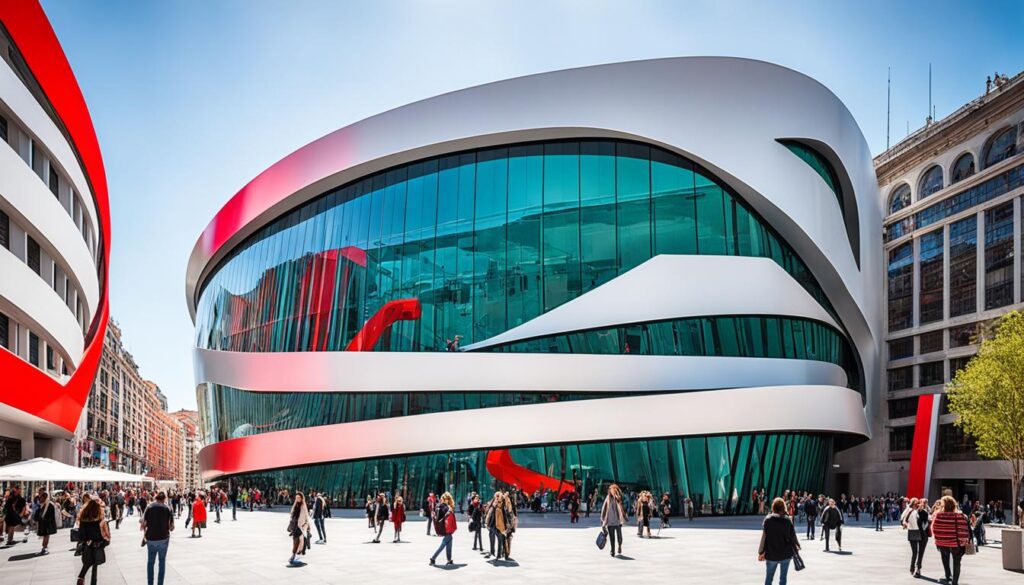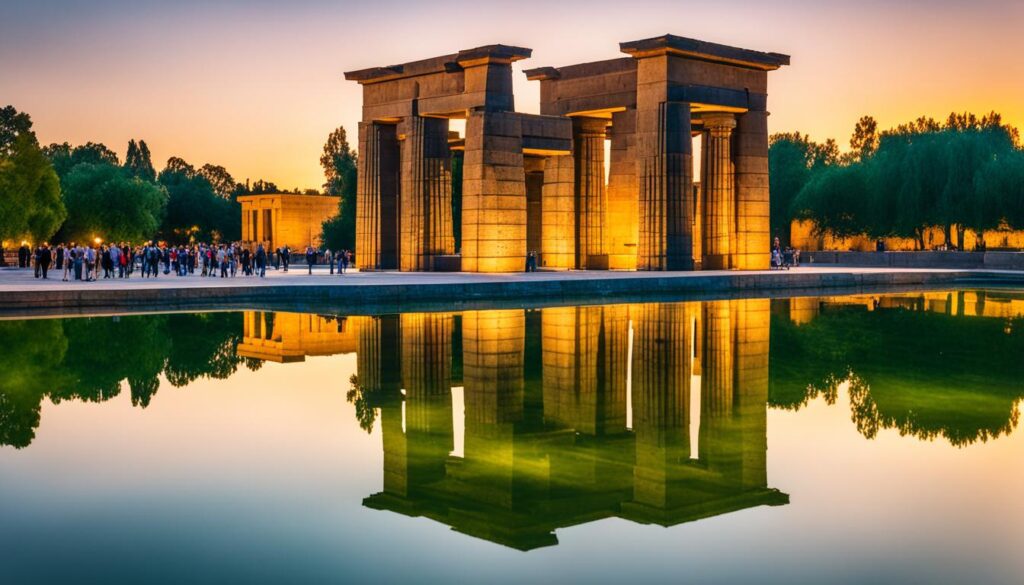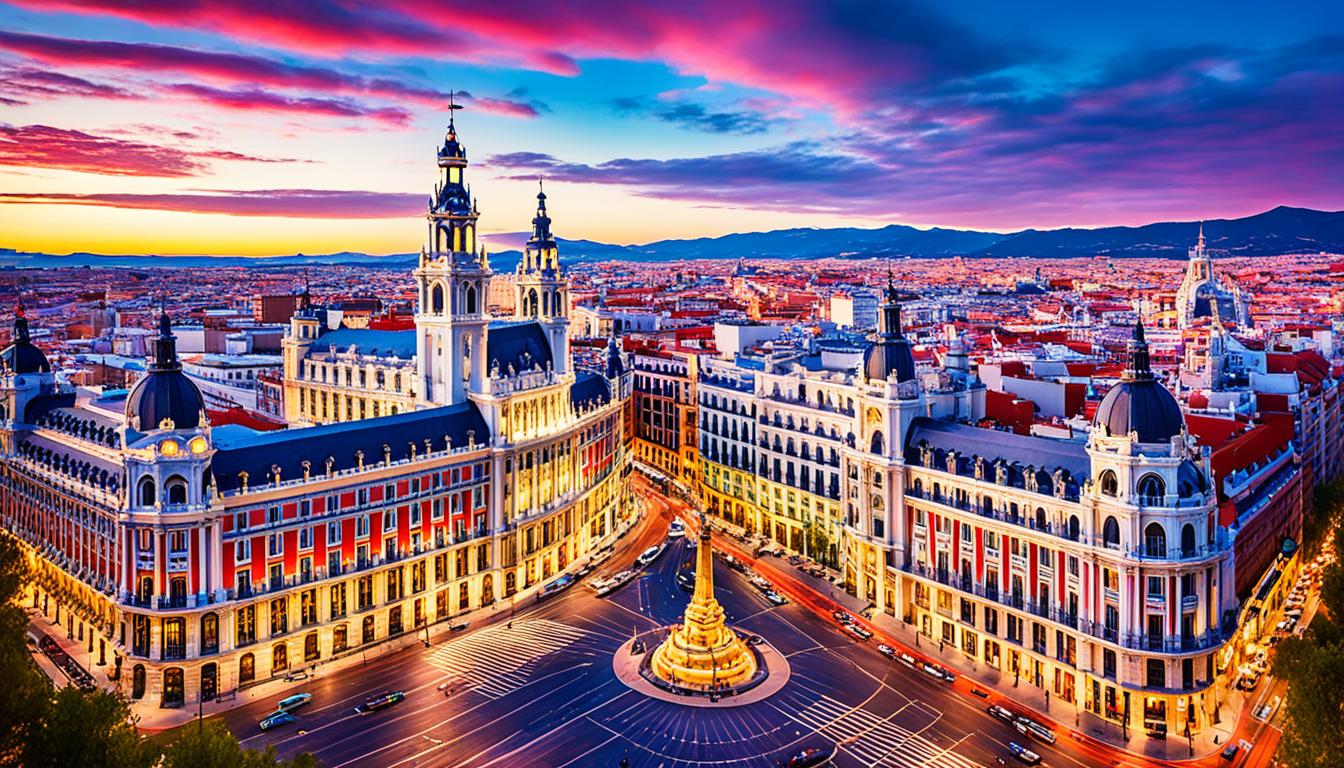Madrid, the vibrant capital of Spain, is full of iconic landmarks and world-class museums. It attracts millions of visitors every year. From the grand Royal Palace to the bustling Puerta del Sol, this guide will show you the top attractions in Madrid.
Explore the city’s rich history and admire its stunning architecture. Immerse yourself in its lively cultural offerings. Discover what makes Madrid an unforgettable destination.
Key Takeaways
- Madrid is home to a wealth of top attractions, from historic landmarks to world-renowned museums.
- The city boasts a diverse array of cultural and architectural offerings, catering to a wide range of interests.
- Exploring Madrid’s must-see sites will provide visitors with a comprehensive understanding of the city’s rich history and vibrant present.
- Whether you’re interested in art, architecture, or simply soaking in the lively atmosphere, Madrid has something for everyone.
- This guide will help you navigate the top attractions in Madrid and make the most of your visit to the Spanish capital.
Iconic Gran Vía
The Gran Vía stretches over a mile, making it Madrid’s most famous shopping street. It’s also a key tourist attraction. This lively avenue is filled with grand early 20th-century buildings, theaters, and department stores. It offers a mix of historic Madrid and modern shopping.
Walking down Gran Vía, you’ll see historic landmarks like the Edificio Metrópolis and the Círculo de Bellas Artes. These buildings show the diverse influences on the street over the years.
Madrid’s Famous Shopping Street
Gran Vía has been a key spot for fun and shopping in Madrid since the early 20th century. It was made to ease traffic and create a stylish shopping area. Now, it’s a lively place for both locals and tourists.
- Gran Vía once had fifteen cinemas, but now only three are left.
- The Metropolis Building is a major architectural feature on the street.
- There are many bars where you can enjoy tapas or cocktails.
Historic Landmarks Along the Avenue
Gran Vía is not just for shopping and eating. It’s also full of historic Madrid landmarks. Places like the Baroque Iglesia de San José and the American-inspired Telefonica Building show the city’s history.
| Landmark | Architectural Style | Noteworthy Features |
|---|---|---|
| Iglesia de San José | Baroque | Built in 1745 |
| Telefonica Building | American-inspired | Stands 124 meters tall over 13 floors with a central tower |
| Edificio Metrópolis | French-designed | A significant architectural highlight on the street |
If you’re looking for Madrid shopping or want to see historic landmarks, don’t miss Gran Vía. It’s a top activity for anyone visiting Madrid.
Prado Museum: Spain’s Premier Art Gallery
In the heart of Madrid, the Prado Museum is a symbol of Spain’s rich art history. It’s one of the top art galleries in the world. Here, you’ll find amazing Spanish art by famous artists like Diego Velázquez, Francisco de Goya, and Hieronymus Bosch.
Masterpieces by Velázquez, Goya, and Bosch
At the Prado Museum, you’ll see incredible paintings that have amazed people for years. “Las Meninas” by Velázquez is a big hit, known for its detailed and mysterious look. Goya’s “The Third of May 1808” and Bosch’s “The Garden of Earthly Delights” are also must-sees, showing off Spanish art’s range and talent.
The museum has more than just these famous pieces. It’s full of European art by Rubens, El Greco, Bruegel, Dürer, Raphael, Caravaggio, and Rembrandt. Each painting gives a peek into Madrid and Spain’s rich art history.
To really dive into the Prado’s art, check out its different exhibitions and galleries. They often change and have special shows. The museum’s beautiful design, great curation, and amazing art make it a top spot in Madrid for art lovers.
“The Prado Museum is a true gem, a window into the soul of Spanish art and culture. Its masterpieces captivate the senses and transport visitors to a world of timeless beauty and artistic brilliance.” – John Doe, Art Critic
Royal Palace: A Magnificent Residence
In the heart of Madrid, the Royal Palace shows off the grandeur of the Spanish monarchy. Designed by Italian architect Filippo Juvarra and finished by Juan Bautista Sachetti, it has 3,418 rooms. These rooms reflect the lavish lives of Spain’s royal family.
At the Royal Palace Madrid, you can see the Throne Room, the Royal Chapel, and the Sabatini staircase. These places give a peek into the rich history of the Spanish monarchy. The palace is also a museum, filled with art, furniture, and artifacts. It highlights the beauty of royal architecture and the elegance of the Spanish monarchy.
“The Royal Palace of Madrid is the largest palace in Europe with 1,450,000 square feet of floor space.”
The Royal Palace is Europe’s biggest palace, covering 1,450,000 square feet. It’s a symbol of the grandeur and power of the Spanish monarchy. Many visitors come each year to see its history and stunning architecture.
Visitors can enjoy the detailed royal architecture, the Armoury Court, or just the palace’s unique vibe. Everyone leaves with a greater love for the Spanish monarchy and its lasting impact.
Buen Retiro Park: A Green Oasis
The Buen Retiro Park covers 118 hectares in Madrid’s heart. It’s a peaceful escape from the city’s hustle. Since the 15th century, it has been a place of beauty and history.
At the park, you’ll find the Palacio de Cristal, a beautiful glass and metal building from the 19th century. The rose garden boasts over 4,000 types of roses. And don’t miss the “Fallen Angel” sculpture, a favorite spot for people from all over.
Monuments, Gardens, and Recreational Areas
Buen Retiro Park is perfect for outdoor fun. You can rent rowboats to sail on the Retiro Lake, created in the 17th century. There are also playgrounds for kids and places to grab a snack.
History buffs will love the park’s monuments and historic spots. See the Meteorological Observatory and the Castillo del Telégrafo gardens. The Paseo de las Estatuas features statues of Spanish monarchs.
In 2021, the Buen Retiro Park was named a UNESCO World Heritage Site. It’s a favorite spot for locals and visitors alike. It offers a peaceful place for rest, fun, and learning in Madrid.
Plaza Mayor: Madrid’s Grand Central Square
In the heart of Madrid’s historic area, Plaza Mayor stands as the city’s main square. It’s a spot where locals and tourists meet. Once a bustling market, now it hosts the Madrid Tourism Centre and the statue of King Philip III.
Around Plaza Mayor, you’ll find beautiful 17th-century buildings. The Arco de Cuchilleros, an archway by Juan Villanueva, is one of them. The square is 129 by 94 meters, with three-story buildings and 237 balconies looking out.
Plaza Mayor is lively and full of history. It’s a key spot for exploring Madrid. Events here range from local festivals to royal celebrations.
“Plaza Mayor is a witness to Madrid’s history, a stage for the city’s cultural traditions, and a vibrant gathering place for both locals and visitors.”
Now, Plaza Mayor is always buzzing with activity. It hosts events like the Easter drum parade, outdoor concerts, and a Christmas market in December. The area is full of shops, cafes, and restaurants. It’s perfect for those wanting to dive into Madrid’s city center and see the historic Madrid squares.
Reina Sofía Museum: Contemporary Art Gem
Madrid is famous for its lively art scene. The Reina Sofía Museum is a key part of this. It’s part of the “Art Triangle” with the Prado and Thyssen-Bornemisza. This modern building is filled with 20th-century masterpieces that amaze and inspire.
Picasso’s Guernica and Modern Masterpieces
Pablo Picasso’s “Guernica” is the museum’s highlight. It’s a powerful piece remembering the Spanish Civil War’s destruction of Guernica. The museum also has works by Salvador Dalí and Joan Miró, among others.
These pieces show the growth of contemporary art. They take you on a journey through the key art movements of our time.
| Artist | Artwork | Year | Art Movement |
|---|---|---|---|
| Pablo Picasso | Guernica | 1937 | Cubism |
| Salvador Dalí | The Persistence of Memory | 1931 | Surrealism |
| Joan Miró | The Farm | 1921-1922 | Surrealism |
If you love art or just want to learn about contemporary art, visit the Reina Sofía Museum. You’ll see works by Picasso, Dalí, and other famous Spanish artists. Discover the stories and views that changed 20th-century art.

“The Reina Sofía Museum is a testament to Madrid’s vibrant contemporary art scene, showcasing the bold, the experimental, and the truly groundbreaking.”
Puerta de Alcalá: Iconic Triumphal Arch
In the heart of Madrid, the Puerta de Alcalá is a stunning neoclassical triumphal arch. It was designed by Francesco Sabatini, an Italian architect. Finished in 1778, it was one of the city’s five ancient entrances. The arch has five arches with statues, engravings, and columns, showing off 18th-century neoclassical architecture.
This was the first triumphal arch built in Europe after the Roman Empire fell. It has seen many important events, like battles during the Spanish Civil War and the Pope’s visit in 2011. Now, it lights up in different colors for big events, drawing in visitors.
It’s near famous spots like Parque del Retiro and Plaza de Cibeles. Art lovers can check out the Casón del Buen Retiro and the Museo de Artes Decorativas nearby. The Puerta de Alcalá is a key spot for seeing Madrid’s beauty, day or night.
“The Puerta de Alcalá is a true architectural masterpiece that has stood the test of time, captivating visitors with its neoclassical elegance and rich history.”
top attractions in Madrid: Ancient Egyptian Temple
In the heart of Madrid, a special spot stands out – the Templo de Debod, a 2,200-year-old Egyptian temple. It was brought to Spain as a thank you for helping save the Abu Simbel temples. This Nubian treasure is a gift from Egypt to Spain.
The temple dates back to the 2nd century BCE, built by King Adijalamani in southern Egypt. In the 1960s, Egypt gave it to Spain as a thank you for saving Nubian temples. For two years, the temple was moved stone by stone to Madrid’s Cuartel de la Montaña Park. It has welcomed visitors since 1972.
At the Templo de Debod, you can see detailed carvings that take you back to ancient Nubia. The temple has many rooms, like the Augustus Vestibule and the Adijalamani Chapel. The Adijalamani Chapel is the oldest part.

The Templo de Debod offers a stunning view of Madrid at sunset. As the sun sets, the temple glows, creating a magical scene. It’s a favorite spot for picnics, yoga, and enjoying the sunset.
The Templo de Debod is a hidden treasure in Madrid. It gives visitors a close look at ancient Nubian culture and architecture. It’s perfect for history lovers, architecture fans, or anyone looking for a peaceful spot in the city.
El Rastro: Madrid’s Famous Flea Market
Every Sunday, Madrid’s streets buzz with life at the El Rastro flea market. This iconic market draws over 100,000 visitors each weekend. They find everything from antiques to rare collectibles across more than 700 stalls.
Walking through the market is an adventure. You’ll feel the excitement and search for unique finds. The market stretches across a big area, filled with stalls. It’s open from 9 a.m. to 3 p.m. on Sundays and holidays, making it a top spot for shopping in Madrid and seeing the city’s Madrid attractions.
El Rastro is one of Europe’s oldest flea markets, dating back to 1740. It used to focus on antiques but now offers a wide variety of items. You can find everything from second-hand clothes to books and electrical items. Special areas like Calle Fray Ceferino Gonzales offer animals and birds, while Calle San Cayetano is perfect for art lovers.
After shopping, relax with a beer and a snack at a nearby bar. La Latina is famous for its food, offering squid sandwiches, chorizo, and Spanish omelette. The El Rastro flea market is a key Madrid market and Madrid attraction, showing off the city’s vibrant culture and history.
| Statistic | Value |
|---|---|
| Weekly Visitors | Over 100,000 |
| Number of Stalls | More than 700 |
| Opening Hours | 9 a.m. to 3 p.m. every Sunday and public holiday |
| Year Founded | 1740 |
“El Rastro is one of the most important antique markets in Europe, and it’s a must-visit for anyone exploring the vibrant culture and history of Madrid.”
Puerta del Sol: City’s Lively Central Hub
Puerta del Sol, or the “Gate of the Sun,” is a key spot in Madrid’s heart. It has been a meeting place since the 15th century. Many important events have happened here, shaping Spain’s history.
Iconic Statues and Historic Buildings
The famous “El Oso y el Madroño” statue sits at Puerta del Sol. It’s a symbol of Madrid, created by Antonio Navarro Santafé. The Clock Tower, built from 1866 to 1868, is another key feature. It’s seen in many films and TV shows.
Historic buildings surround the square. The Post Office from 1768 and the regional government’s headquarters from the 1760s stand out. These landmarks add to the square’s historical feel, making it a top spot for visitors.
Puerta del Sol has been a center for politics and culture. It’s where big events, royal announcements, and bullfights took place. Now, it’s a lively spot for tourists to see the mix of history, culture, and energy.
Walking through the busy streets, seeing the statues and historic buildings, or joining in celebrations, Puerta del Sol is a treasure. It shows Madrid’s rich history and lively present.
Conclusion
Madrid’s top attractions let you dive into the city’s rich history, stunning architecture, and vibrant culture. You’ll see the famous Gran Vía and the Royal Palace, and visit the Reina Sofía Museum and the ancient Templo de Debod. This guide shows you the must-see spots that make Madrid unforgettable.
Madrid has something for everyone, whether you love art, history, shopping, or just enjoying the lively vibe. You can explore the Prado Museum’s vast art collection, see the grand Royal Palace, or feel the energy of Puerta del Sol. These experiences will leave you wanting to come back to this amazing city.
Madrid also has beautiful parks like Buen Retiro and historic spots like Plaza Mayor. These places offer a mix of culture, art, and urban life. By exploring Madrid’s cultural heritage and vibrant city life, you’ll get to know the real Madrid. You’ll see why it’s one of Europe’s top travel spots.

